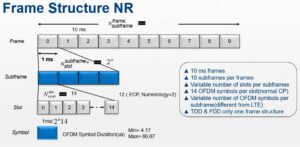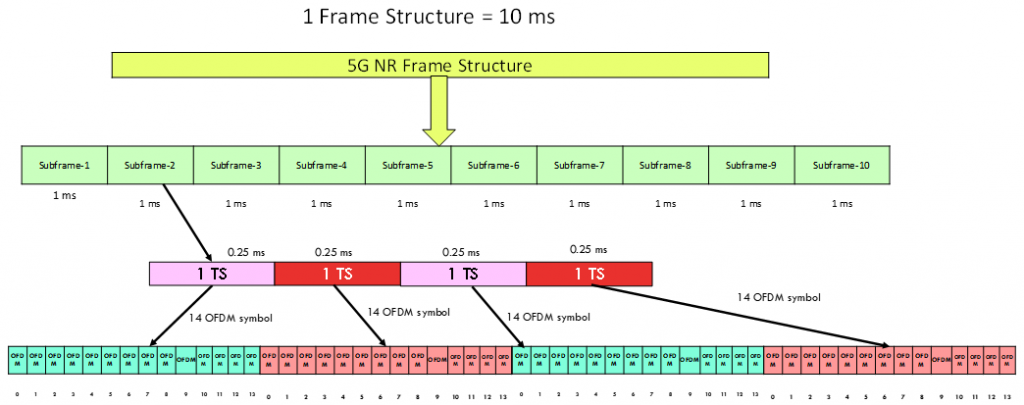Frame Structure 5G-NR
- In NR, similar to LTE, a radio frame is fixed to be 10 ms, which consists of 10 subframes each of 1ms. However, different from LTE which has a fixed subcarrier spacing (SCS) for 15 kHz, NR supports scalable numerology for more flexible deployments covering a wide range of services and carrier frequencies. In particular, NR supports the following SCSs (f0):
- f0 = 15 kHz * 2m, where m = {0, 1, 2, 3, 4}, i.e., f0 = {15, 30, 60, 120, 240} kHz
- Note that 15 kHz, 30 kHz and 60 kHz are applicable to carrier frequencies of 6 GHz of lower (sub-6), where 60 kHz, 120 kHz and 240 kHz are applicable to above 6 GHz carrier frequencies.
- In the time domain, the subframe length of NR is 1 ms, which is composed of 14 OFDM symbols using 15 kHz subcarrier spacing and normal CP.
- A subframe is composed of an integer number of slots, and each slot consists of 14 OFDM symbols. Each slot can carry control signals/channels at the beginning and/or ending OFDM symbol-(s).
- 5G frame structures provide a fixed overall structure for defining data block transmission timing. Radio frames and subframes are of fixed lengths. They are chosen to be the same as in LTE, thereby allowing for better LTE-NR co-existence. In case of co-site deployment, slot- and frame structures may be aligned to simplify cell search and inter-frequency measurements. Coordination of control signals and channels in time domain will also be feasible to avoid interference between LTE and NR.
Numerologies
Multiple OFDM numerologies are supported as given by Table 4.2-1 was and the cyclic prefix for downlink or uplink bandwidth part is obtained from the higher-layer parameter subcarrier spacing and cyclic prefix, respectively.

Frame structures of different numerologies should be adaptive, i.e., the length of (shortened) transmission time intervals (TTIs) and subcarrier spacing should be designed according to the richness of the channel.

A single unified frame structure enabling all 5G scenarios and use cases Enabling low latency while retaining efficiency for non-latency-critical services Paired and unpaired spectrum (FDD and TDD)
Numerology =0 , SCS= 15 KHz, 1 Frame Structure = 10 Subframe, 1 Subframe = 1 Time Slot, 1 Time slot = 14 OFDM symbol

-
When using Frequency Division Duplex (FDD), the symbols belonging to the downlink carrier are used for Base Station transmissions, while the symbols belonging to the uplink carrier are used for UE transmissions.
-
When using a Supplemental Downlink (SDL) carrier, all symbols are used for Base Station transmissions. Similarly, when using a Supplemental Uplink (SUL) carrier, all symbols are used for UE transmissions.
-
When using Time Division Duplex (TDD), one subset of symbols is used for Base Station transmissions, while another subset is used for UE transmissions. A third subset is used for transceiver switching and guarding against the impact of air-interface propagation delay. The ‘slot format’ determines which symbols arc used for each purpose.
Frame Structure with Numerology 0, subcarrier spacing 15 KHz
Numerology =1 , SCS= 30 KHz ,1 Frame Structure = 10 Subframe, 1 Subframe = 2 Time Slot, 1 Time slot = 14 OFDM symbol

Numerology =2 , SCS=60 KHz 1 Frame Structure = 10 Subframe, 1 Subframe = 4 Time Slot, 1 Time slot = 14 OFDM symbol

-
NR frame structure supports slot aggregation and mini-slots.
-
Slot aggregation refers to the case when transmission can span two or more slots in order to achieve improved coverage and/or reduced overhead.
-
Mini-slots (also known as non-slot-based scheduling) refers to the case when transmission can span a number of symbols significantly less than the number of symbols in a slot (14), e.g., as small as 1-symbol.
-
This provides more flexible resource management for a cell and possibilities to achieve low latency (LL), which when combined with ultra-reliability (UR) readily brings URLLC (URLL communications) services.
Slots:

Number of OFDM symbols per slot, slots per frame, and slots per subframe for normal cyclic prefix

Number of OFDM symbols per slot, slots per frame, and slots per sub-frame for extended cyclic prefix







